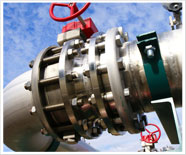Hot-air injection with vapor extraction for diesel fuel cleanup
Santa Monica, California

Initially, Lindmark Engineering conducted site investigations of soil conditions, then designed and specified a soil remediation system for a municipal fire station. Releases of gasoline and diesel from an old underground storage tank system had contaminated the soil. Estimated masses of petroleum hydrocarbons as gasoline and as diesel in the soil were 475 and 1,800 pounds, respectively.
We evaluated several remediation technologies and selected hot-air injection, in conjunction with vapor extraction, as the most technologically sound alternative because of the diesel: a relatively heavy-chain hydrocarbon. We determined that conventional vapor extraction would not have worked because heavy-chain hydrocarbon removal and other remediation alternatives were either too uncertain, costly, or difficult. At this site, air at about 700°F was introduced into three injection wells, two of which were slanted to address contamination beneath a building. Two vapor extraction wells eventually extracted a hydrocarbon-contaminated air stream at about 200°F through a thermal oxidizer, which operated at 1400°F to break down the petroleum hydrocarbons.
Exhaust gas at 1400°F merged with ambient air that was warmed by passing through a blower (130°F) in the heat exchanger to efficiently produce the 700°F injection air stream. After passing through the oxidizer, this air stream met standards for atmospheric emissions set by the South Coast Air Quality Management District.
We operated the remediation system for eighteen months, extracting more than 6,500 pounds (980 gallons) of petroleum hydrocarbons from the ground. We were able to achieve additional contamination reduction because the higher soil temperature created optimal conditions for biodegradation. The next stage was a rebound procedure in which the subsurface gas was allowed to equilibrate, followed by verification sampling of subgrade soil. Laboratory analytical results from the soil samples indicated no petroleum hydrocarbon concentrations above regulated levels. The agency closed the site, recommending no further action.
For more information about this project and how we can accommodate you, please contact Lindmark Engineering.


